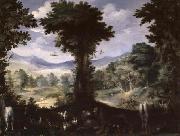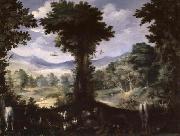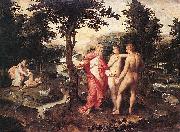Wholesale Oil Painting No Minimum |
|||||||||||
|
|
|||||||||||

|
|||||||||||
|
|
|
||||||||
Thomas Cole1801-1848 Thomas Cole Galleries Thomas Cole (February 1, 1801 - February 11, 1848) was a 19th century American artist. He is regarded as the founder of the Hudson River School, an American art movement that flourished in the mid-19th century. Cole's Hudson River School, as well as his own work, was known for its realistic and detailed portrayal of American landscape and wilderness, which feature themes of romanticism and naturalism. In New York he sold three paintings to George W. Bruen, who financed a summer trip to the Hudson Valley where he visited the Catskill Mountain House and painted the ruins of Fort Putnam. Returning to New York he displayed three landscapes in the window of a bookstore; according to the New York Evening Post, this garnered Cole the attention of John Trumbull, Asher B. Durand, and William Dunlap. Among the paintings was a landscape called "View of Fort Ticonderoga from Gelyna". Trumbull was especially impressed with the work of the young artist and sought him out, bought one of his paintings, and put him into contact with a number of his wealthy friends including Robert Gilmor of Baltimore and Daniel Wadsworth of Hartford, who became important patrons of the artist. Cole was primarily a painter of landscapes, but he also painted allegorical works. The most famous of these are the five-part series, The Course of Empire, now in the collection of the New York Historical Society and the four-part The Voyage of Life. There are two versions of the latter, one at the National Gallery in Washington, D.C., the other at the Munson-Williams-Proctor Arts Institute in Utica, New York. Cole influenced his artistic peers, especially Asher B. Durand and Frederic Edwin Church, who studied with Cole from 1844 to 1846. Cole spent the years 1829 to 1832 and 1841-1842 abroad, mainly in England and Italy; in Florence he lived with the sculptor Horatio Greenough. |
||||||||
|
|
||||||||
Garden of Eden
Garden of Eden Painting ID:: 9898 |
1828 Oil on canvas
Amon Carter
Museum,
Fort Worth, Texas 1828 Oil on canvas Amon Carter Museum, Fort Worth, Texas |
|||||||
|
|
||||||||
Carlo Antonio Procaccini(born 1555) was an Italian painter of the late-Renaissance period. He was the third son of Ercole, the brother of Camillo and Giulio Cesare the elder, and father of Ercole Procaccini the Younger (1605?C1675). He was born at Bologna and initially trained by his father, though he excelled in painting landscapes and still-lifes with flowers and fruit, mainly in Milan. |
||||||||
|
|
||||||||
|
|
Garden of Eden
Garden of Eden Painting ID:: 71190 |
16th century
Oil on panel
34 x 46 cm
16th century Oil on panel 34 x 46 cm |
||||||
|
|
||||||||
PROCACCINI, Carlo AntonioItalian painter, Lombard school (b. 1555, Bologna, d. 1605, Milano) |
||||||||
|
|
||||||||
|
|
Garden of Eden
Garden of Eden Painting ID:: 72322 |
Date 16th century
Medium Oil on panel
Dimensions 34 x 46 cm
cyf Date 16th century Medium Oil on panel Dimensions 34 x 46 cm cyf |
||||||
|
|
||||||||
Jacob de Backer(c. 1555 - c. 1585) was a Flemish Mannerist painter and draughtsman active in Antwerp between about 1571 and 1585. According to the RKD he was born in Antwerp in c.1540/45 and died there c.1591-1600.De Backer was abandoned by his father as a young boy. Carel van Mander reports that the artist studied with Antonio van Palermo and Hendrik van Steenwijk I, but that Palermo worked him so hard that the young de Backer died in the arms of his master's daughter at the age of thirty. Although the artist painted in the high mannerist style of Giorgio Vasari, he never appeared to travel to Italy. A series of the "Seven Deadly Sins", however, was bought in Antwerp by Alessandro Farnese's secretary Cosimo Masi in 1594 and taken to Italy.These paintings are now in the Museo di Capodimonte in Naples. Other attributable works include a Last Judgment triptych by him or his studio for Christophe Plantin's tomb in the Antwerp Cathedral (c. 1589; illustrated right), and an Allegory of the Three Ages of Man in the Hermitage Museum, St. Petersburg. He is not to be confused with the Dutch Golden Age painter Jacob Adriaensz Backer from |
||||||||
|
|
||||||||
|
|
Garden of Eden
Garden of Eden Painting ID:: 85901 |
Date second half of 16th century
Medium Oil on oak panel
Dimensions Height: 77.5 cm (30.5 in). Width: 107.5 cm (42.3 in).
cjr Date second half of 16th century Medium Oil on oak panel Dimensions Height: 77.5 cm (30.5 in). Width: 107.5 cm (42.3 in). cjr |
||||||
|
|
||||||||
Jacob de Backer(c. 1555 - c. 1585) was a Flemish Mannerist painter and draughtsman active in Antwerp between about 1571 and 1585. According to the RKD he was born in Antwerp in c.1540/45 and died there c.1591-1600.De Backer was abandoned by his father as a young boy. Carel van Mander reports that the artist studied with Antonio van Palermo and Hendrik van Steenwijk I, but that Palermo worked him so hard that the young de Backer died in the arms of his master's daughter at the age of thirty. Although the artist painted in the high mannerist style of Giorgio Vasari, he never appeared to travel to Italy. A series of the "Seven Deadly Sins", however, was bought in Antwerp by Alessandro Farnese's secretary Cosimo Masi in 1594 and taken to Italy.These paintings are now in the Museo di Capodimonte in Naples. Other attributable works include a Last Judgment triptych by him or his studio for Christophe Plantin's tomb in the Antwerp Cathedral (c. 1589; illustrated right), and an Allegory of the Three Ages of Man in the Hermitage Museum, St. Petersburg. He is not to be confused with the Dutch Golden Age painter Jacob Adriaensz Backer from |
||||||||
|
|
||||||||
|
|
Garden of Eden
Garden of Eden Painting ID:: 90052 |
second half of 16th century
Medium Oil on oak panel
Dimensions Height: 77.5 cm (30.5 in). Width: 107.5 cm (42.3 in).
cyf second half of 16th century Medium Oil on oak panel Dimensions Height: 77.5 cm (30.5 in). Width: 107.5 cm (42.3 in). cyf |
||||||
|
|
||||||||
|
Jacob de Backer (c. 1555 - c. 1585) was a Flemish Mannerist painter and draughtsman active in Antwerp between about 1571 and 1585. According to the RKD he was born in Antwerp in c.1540/45 and died there c.1591-1600.De Backer was abandoned by his father as a young boy. Carel van Mander reports that the artist studied with Antonio van Palermo and Hendrik van Steenwijk I, but that Palermo worked him so hard that the young de Backer died in the arms of his master's daughter at the age of thirty. Although the artist painted in the high mannerist style of Giorgio Vasari, he never appeared to travel to Italy. A series of the "Seven Deadly Sins", however, was bought in Antwerp by Alessandro Farnese's secretary Cosimo Masi in 1594 and taken to Italy.These paintings are now in the Museo di Capodimonte in Naples. Other attributable works include a Last Judgment triptych by him or his studio for Christophe Plantin's tomb in the Antwerp Cathedral (c. 1589; illustrated right), and an Allegory of the Three Ages of Man in the Hermitage Museum, St. Petersburg. He is not to be confused with the Dutch Golden Age painter Jacob Adriaensz Backer from Garden of Eden second half of 16th century Medium Oil on oak panel Dimensions Height: 77.5 cm (30.5 in). Width: 107.5 cm (42.3 in). cyf |
||||||||
|
|
||||||||
|
Prev Next
|
||||||||
|
|
||||||||
|
Related Paintings to Jacob de Backer :. |
||||||||
|
|
||||||||
|
CONTACT US |





